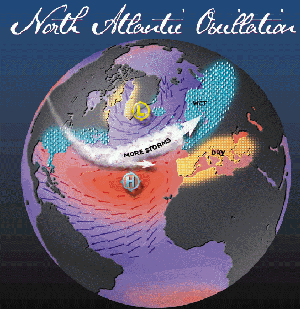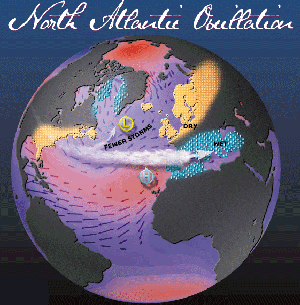 > English > Climate Encyclopaedia > Weather > more > 2. Major wind systems > - NAO
> English > Climate Encyclopaedia > Weather > more > 2. Major wind systems > - NAO
|
WeatherMore |
NAONorth Atlantic Oscillation (NAO) Climate variability comprises three primary, but interrelated phenomena in the North Atlantic region:
The NAO is a fluctuation in a sea level pressure difference between Iceland and the Azores. The name was first cited by Gilbert Walker in 1924.
|
The history of the NAOThe NAO has a long history. The missionary Hans Egede Saabye made observations in his diary as far back as 1770 to 1778: "When the winter in Denmark was severe, as we perceive it, the winter in Greenland in its manner was mild, and conversely". Simultaneously, coherent fluctuations in temperatures, rainfall and sea level pressure were documented, reaching eastwards to central Europe, southwards to subtropical West Africa and westward to North America. The fluctuations of NAO influence climate from North America to Siberia and from the Arctic Ocean to the equator.
|
The negative NAO index phase shows a weak subtropical high and a weak Icelandic low. The reduced pressure gradient results in fewer and weaker storms crossing on a more west-east pathway. They bring moist air into the Mediterranean and cold air outbreaks and hence snowy weather conditions. Greenland, however, has milder winter temperatures. The low index winter/springs of 1917, 1936, 1963, and 1969 had weaker mean westerlies over the North Atlantic Ocean with corresponding colder than normal European winters. |
|
|
|
 |
|
3. source: http://www.ldeo.columbia.edu/res/pi/NAO/ |
|
|
|
|
References:http://www1.secam.ex.ac.uk/cat/NAOMarshall, J. et al., 2001: Nort Atlantic climate variability: phenomena, impacts and mechanisms. Int’l Journal of Climatology, 1863-1898 pp.
|


